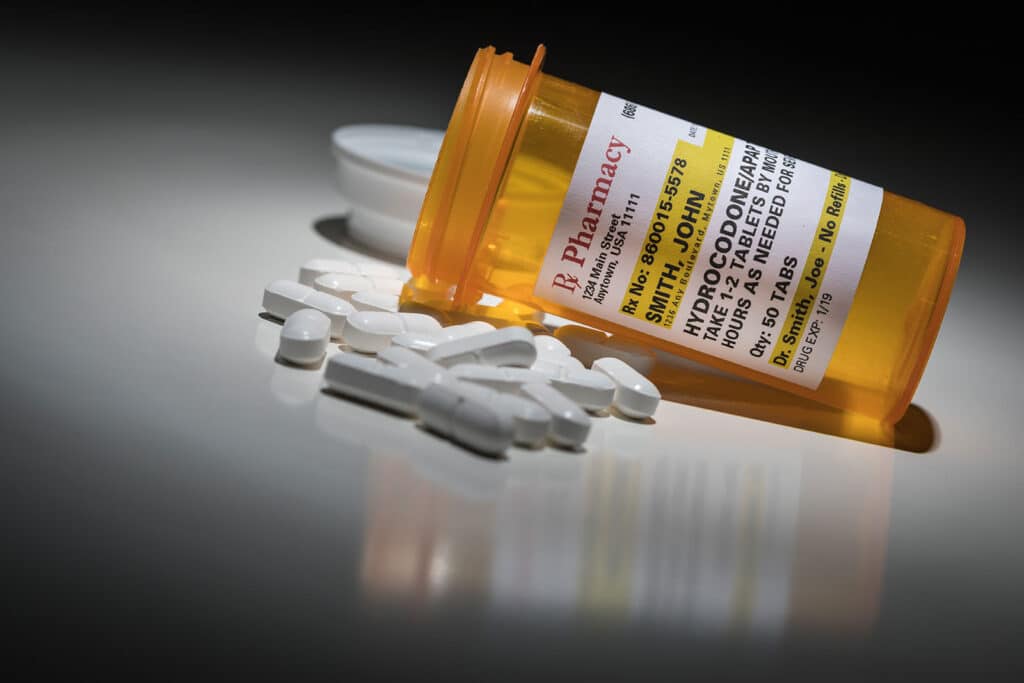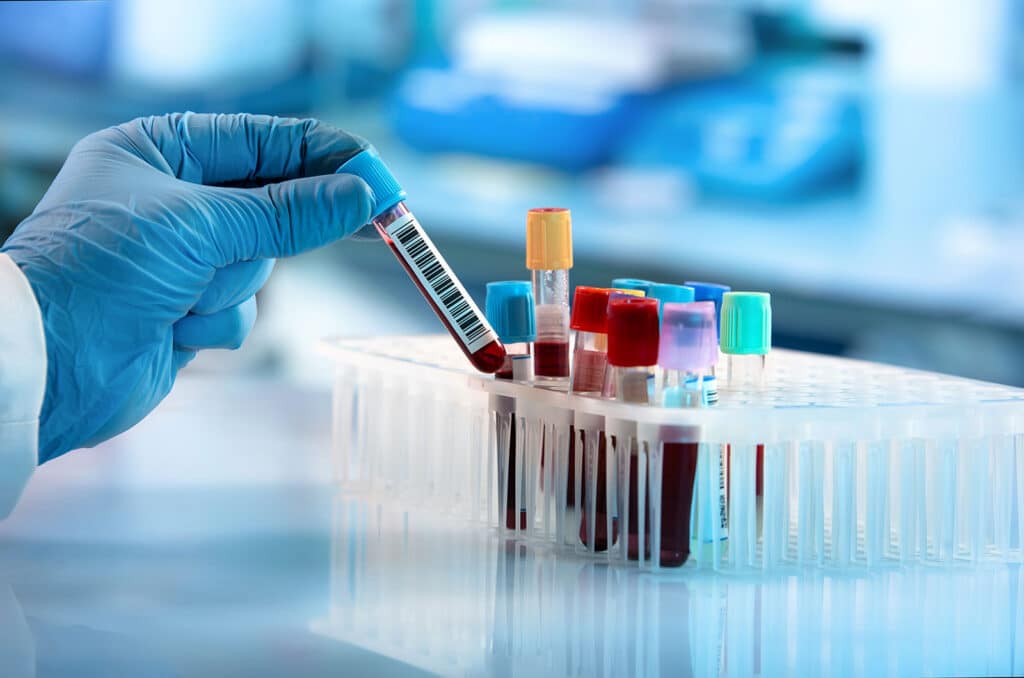To say opioid use disorders (OUDs) are a problem in the U.S. would be a gross understatement. In 2017, then-President Donald J. Trump declared OUDs a national public health emergency. And more recently, a study published by the National Institutes of Health (NIH) revealed some 3 million Americans once had or currently still have a problem with opioids. So that everyone is on the same page, multiple drugs fall under the umbrella of opioids, with some of the most popular being heroin, OxyContin, and fentanyl. But hot on their heels is hydrocodone, an opioid-based prescription analgesic commonly prescribed to treat moderate to moderately severe pain. And like heroin, OxyContin, and fentanyl, it is highly addictive.
Table of Contents
Why Some People Develop a Hydrocodone Addiction
Like most other opioids, hydrocodone addiction happens when someone develops a tolerance for the drug and has to take more of it to relieve pain, achieve a desired euphoric high, or both. To better understand these two distinctly different factors, we must look at the two individually. Some people with a hydrocodone addiction never set out to have such an addiction. Available data shows some people started taking the drug explicitly to alleviate pain resulting from an injury or pain they experienced following surgery. Some reportedly started taking hydrocodone to combat pain brought on by an underlying disease, such as arthritis, osteoarthritis, or fibromyalgia.

Many individuals who took hydrocodone as prescribed for these legitimate reasons developed a tolerance that lured them into taking more of the drug than they were supposed to and, as a byproduct of that, developed a severe addiction. That all said, let’s shift gears and discuss people who take hydrocodone explicitly to get high. When someone takes hydrocodone for the first time strictly to get high, they experience a rush of dopamine, a feel-good chemical released in the brain. But that dopamine rush becomes less and less intense the more they continue to take the drug, which leads to them having to take more to achieve the same euphoric high and ultimately developing an addiction.
Signs of Hydrocodone Addiction
Whether someone abuses hydrocodone to get high, alleviate pain, or both, the tell-tale signs of addiction will eventually present themselves. One of the most common and undoubtedly more concerning signs of hydrocodone addiction is respiratory depression. For those unaware, respiratory depression refers to shallow breathing. If hydrocodone-induced respiratory depression is severe enough, it can lead to coma or death. Additional signs of hydrocodone addiction include the following:
- Hypotension
- Bradycardia
- Lightheadedness
- Itchiness
- Headache
- Insomnia
- Nausea
- Vomiting
What Happens When Someone Tries To Quit Hydrocodone?

While some people are fully content living a life delineated by hydrocodone addiction, others are not. Those are the ones who are turning to licensed rehab facilities all across the U.S. for help, primarily because they are mindful of how difficult it is to overcome opioid addiction alone. When someone abruptly stops taking a short-acting version of hydrocodone, such as Norco or Vicodin, they usually experience withdrawal symptoms within 4 to 6 hours of taking their final dose. Likewise, when someone suddenly stops taking an extended-release version, such as Zohydro ER or Hysingla ER, withdrawal symptoms kick in within 12 hours. Some of the side effects of quitting either short-acting or extended-release hydrocodone include the following:
- Anxiety
- Chills
- Drowsiness
- Intense drug cravings
- Gastrointestinal problems
- General aches and pain
- Insomnia
- Muscle spasms
- Profuse sweating
- Restlessness
- Stomach cramps
- Tachycardia
These various symptoms are part and parcel of detoxing from all forms of hydrocodone. For those who don’t already know, detoxing is the body’s natural way of ridding itself of hydrocodone and other harmful contaminants. It is also one of the most challenging parts of addiction recovery. But it does get a little easier once withdrawal symptoms have peaked. To that point, hydrocodone-related withdrawal symptoms typically peak 72 hours after an individual takes their final dose. But this doesn’t mean it’s smooth sailing from that point on. Some symptoms, such as drug cravings, anxiety, and insomnia, can linger for weeks or months. Multiple factors influence the type of withdrawal symptoms someone will experience as they go through detox. The same applies to the severity and duration of those symptoms. Some of these factors include the following:
- If an individual has an underlying physical or psychological problem
- If an individual is mixing hydrocodone with alcohol or other drugs
- The length of time an individual has been on hydrocodone and the dose they are taking
- Whether an individual is taking short-acting or extended-release hydrocodone
To help someone cope with hydrocodone withdrawal symptoms, most rehab facilities offer medication-assisted detox, which involves providing them with FDA-approved drugs. These drugs, some of which include buprenorphine, naloxone, methadone, and naltrexone, help combat pain, gastrointestinal issues, and other symptoms synonymous with going through a hydrocodone detox.

How Long Hydrocodone Stays in Your System
If someone undergoes a drug test, hydrocodone can be detected in their system for weeks or months after they have stopped using. The type of test given and when someone takes it has a huge say in whether or not they test positive or negative for hydrocodone. For example, because of its half-life of roughly 3.3 to 4.1 hours, not to mention how well it is absorbed once in the gastrointestinal tract, hydrocodone can show up in one’s blood 18 to 24 hours after their last dose. The timeframes associated with other testing methods are as follows:
| Testing Method | Detection Window After Last Dose | Notes |
|---|---|---|
| Blood Test | 18 to 24 hours | Reflects hydrocodone’s short half-life and absorption rate. |
| Urine Test | 1 to 4 days | Most commonly used method for drug testing. |
| Saliva Test | 12 to 36 hours | Quick and non-invasive; shorter detection window. |
| Hair Test | Up to 90 days | Longest detection window; can show historical use. |
Factors That Can Influence the Elimination of Hydrocodone From the Body
Like withdrawal symptoms, several factors can influence the elimination of hydrocodone from someone’s body, some of which include
Genetics
Many bodily functions are dictated by our genes, including how quickly and effectively we can metabolize hydrocodone and other drugs. Two enzyme systems in the body are responsible for metabolizing hydrocodone and other opioids once they enter the body. They are called CYP450 and UDP-glucuronosyltransferases (UGTs), and the quality and quantity of these enzymes are determined based on human genetics.
Liver and kidney function
Our kidneys and liver work in tandem to remove numerous substances from our bodies, including drugs. If someone has a health condition that adversely affects how these two systems function, it can take longer for hydrocodone and other opioids to leave their system. Aside from chronic diseases, consuming an unhealthy diet, leading a sedentary lifestyle, and dehydration are the leading causes of liver and kidney problems.
Age
In short, metabolism refers to the body’s capacity to combine calories and oxygen to create and release energy that enables organs to function. Metabolism naturally slows down as we age, which means it can take longer for the liver, kidneys, and other organs to push hydrocodone out of an older individual’s system than a younger individual’s system.
Conclusion
In summary, hydrocodone is an effective opioid-based pain reliever, and it has helped thousands of people cope with chronic pain. But things can quickly go awry when individuals become addicted to it. If you or a loved one is struggling with hydrocodone dependency, know that various addiction treatment options exist, including inpatient and outpatient programs tailored to different needs and circumstances. To learn more about overcoming hydrocodone addiction or about how long hydrocodone remains in your system after you have stopped using, consider speaking with a Garden State Treatment Center associate today.
FAQ
How long does Hydrocodone stay in urine?
Published on: 2023-03-28
Updated on: 2025-03-26



